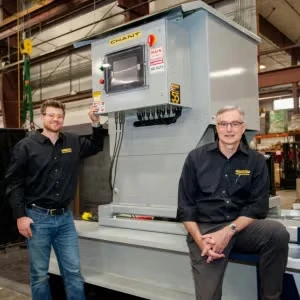Ergonomics: A Top Priority for Safe Lifting
Ergonomic lifting practices are of paramount importance, whether you are engaging in manual lifting or utilizing a lifting device. Lifting tasks that involve awkward postures, repetitive motions, forceful exertions, or static postures carry the risk of musculoskeletal disorders (MSDs) for workers involved in material handling. These risks can persist when equipment like a crane is used for lifting, as factors such as pendant height must be appropriately adjusted to ensure ergonomic operation. Ensuring the safety of your workforce should always be a top priority.
Meeting both your ergonomic and performance objectives with a crane is entirely achievable. In this article, we will explore the options available for lifting light loads using an overhead crane. These types of cranes can be configured to meet your performance needs while replacing manual lifting and manual material handling.
Jib Cranes: Precision and Efficiency
Jib cranes offer an ideal solution when the lifting process can replace manual lifting within a specific area of focus, optimizing part of a production process for increased efficiency. These cranes can be mounted to a wall, building column, or a freestanding pillar. The reach of the jib boom is dependent on its length with the force required to rotate the jib boom increasing as the load is positioned closer to the pivot point.
The choice of jib arm is influenced by factors such as lifting capacity, with options including I-beams for heavier loads and steel or aluminum enclosed rail tracks for lighter loads. When manual rotation is required, it's advisable to position the load within the outer two-thirds of the boom length. Electric motorized rotation is available for high-capacity jib cranes.
Jib cranes attached to a wall or building column provide an economical and space-saving way to integrate a crane into an area requiring light lifting. The suitability of the wall or building column to support the imposed loads should be assessed.
A freestanding pillar is attached to the concrete floor. In many cases, these pillar-mounted jib cranes can be anchored to an existing concrete floor, provided it meets the proper specifications. If not, a foundation with embedded anchors can be added to support the pillar.
Various devices can be attached to jib cranes to facilitate ergonomic lifting, with hoists being one of the most common options. Electric chain hoists, in particular, are cost-effective and versatile, accommodating a wide range of lifting requirements. Additionally, many hoists can be equipped with additional attachments and manipulators to enhance their lifting capabilities, making them effective and efficient.
Workstation Crane and Monorail Systems: Streamlining Material Flow
When the need for a crane extends to material flow and ergonomic lifting, an enclosed track workstation crane system can be a valuable asset. These systems are designed for lighter lifting tasks, generally up to 2 tons, to help enhance the production or manufacturing area's process flow. They typically use enclosed rail sections made of either steel or aluminum. Aluminum track profiles are favored for their ergonomic attributes, given their low physical weight and minimal rolling resistance. Steel tracks, on the other hand, can handle higher capacities and span longer distances while maintaining low rolling resistance.
Just like any other crane, various lifting and handling devices can be attached to the system to support ergonomic lifting within the workspace. Options range from off-the-shelf solutions like chain hoists and balancers. Custom-designed devices such as manipulators and grippers can be integrated into lifting devices to meet specific process needs.
Electric chain hoists are versatile workhorses suitable for a wide range of processes. The addition of grippers or tongs can transform a simple chain hoist into a tailored solution that precisely aligns with your requirements. Air balancers and electric balancers are ideal for assembly processes, offering operators ergonomic means of maneuvering loads and enhancing existing workflows.
Freestanding Workstation Cranes: Versatile and Flexible
Configure an enclosed track crane system as a freestanding workstation crane for a practical solution to add lifting capabilities within areas with existing processes and machinery. These systems are not dependent on ceiling mounting or other structural steel support, allowing for strategic placement in various parts of your workspace. Freestanding workstation cranes optimize unused floorspace to improve material flow and add ergonomic lifting capabilities.
There are distinct freestanding structure configurations to consider, each tailored to your specific needs. The standard portal freestanding workstation consists of evenly spaced posts on both sides, offering a degree of flexibility while serving various requirements. Alternatively, a lamppost-style structure provides a high degree of flexibility in post placement to accommodate existing machinery and building elements. A cantilever configuration features overhanging supports for runways and bridges, leaving one side of the crane completely open. The open side makes it ideal for areas requiring easy access of machinery, improving safety and efficiency.
Ceiling Suspended Enclosed Track Crane Systems: Maximizing Space Efficiency
Ceiling-suspended enclosed track crane systems present a unique advantage in that they don't occupy valuable floor space, unlike freestanding systems and jib cranes that require additional floor-mounted columns for support. Suspended from the structural steel of your building, these suspension cranes can meet a wide range of lifting requirements. Flexible to your unique requirements, the runway length is virtually unlimited, and a number of bridges can service different areas underneath the crane.
Gantry Cranes: Portable Lifting Solutions
Gantry cranes come in various types designed to address specific lifting needs. Gantry cranes for light lifting are essentially portable crane units and are often referred to as portal cranes. These systems consist of two freestanding posts with wheels that support an enclosed track monorail and a chain hoist. They can be effortlessly moved over a smooth floor to areas requiring lifting operations.
In contrast, gantry cranes for heavy lifting typically run on tracks on the floor and are not manually movable due to the substantial weight of the crane configuration and the loads they handle. Remotes are used to facilitate lifting and load travel.
Tailored Crane Solutions for Light Loads
No matter the load weight or the complexity of your material handling processes, ensuring ergonomic lifting practices is crucial. Collaborating with an experienced crane manufacturer and crane dealer allows for the creation of customized solutions that meet your specific requirements. Whether you're considering a workstation crane, jib crane, freestanding workstation crane, or gantry crane, the right choice will significantly enhance your ability to lift and handle light loads effectively, both today and in the future.
Learn more about the solutions available with Demag KBK Crane Systems. Reach out to our experts to discuss your requirements.






